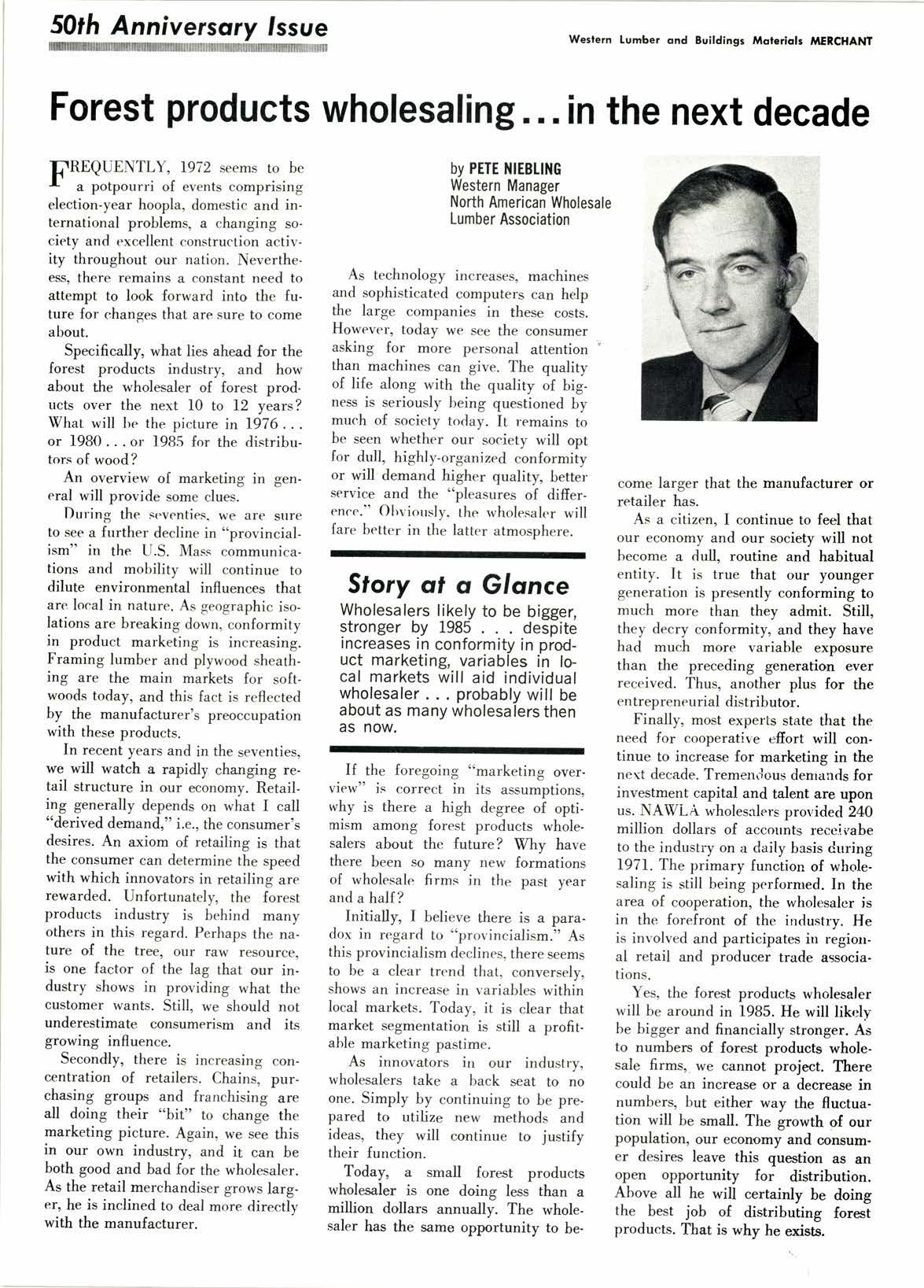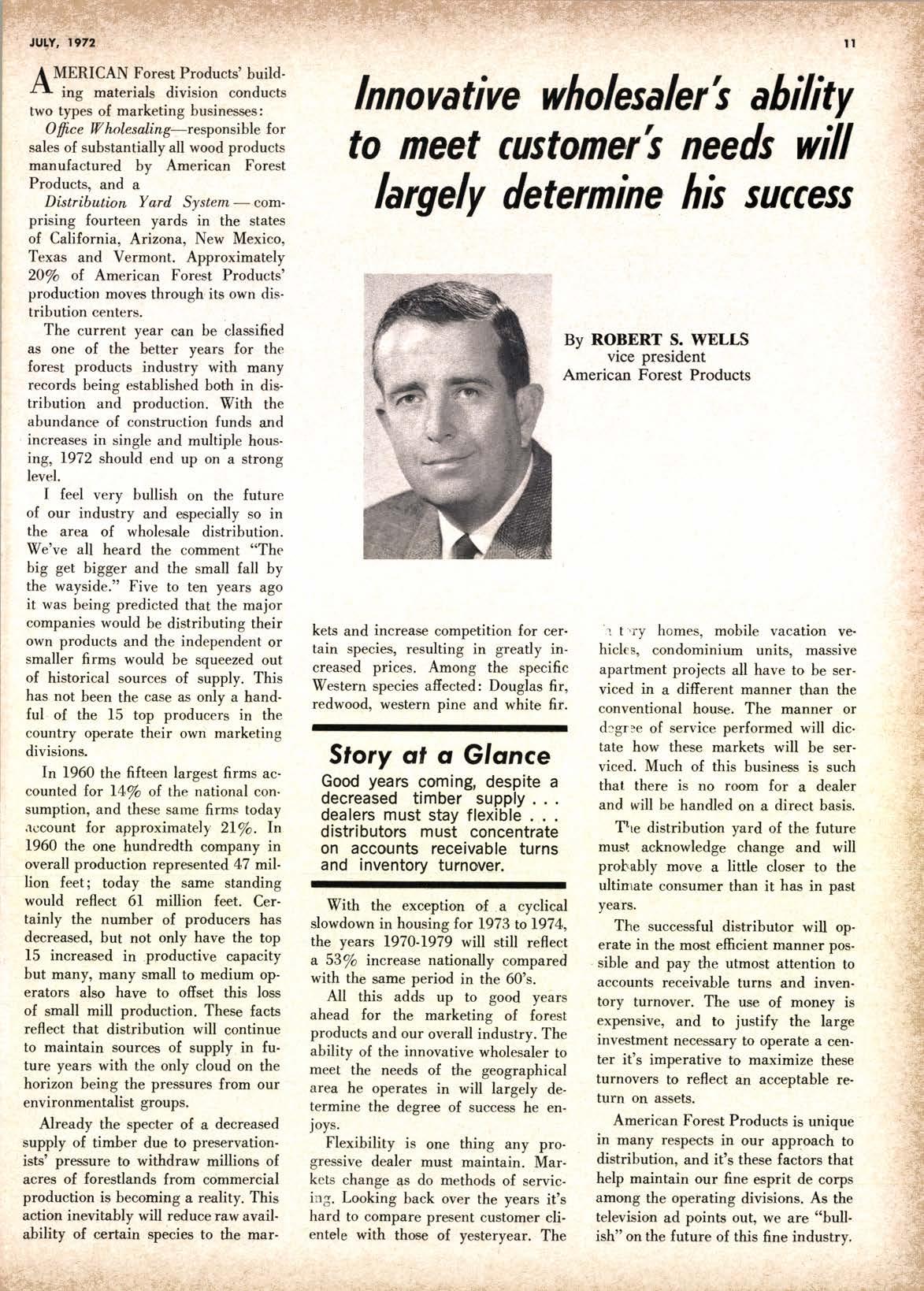
6 minute read
Forest products wholesaling... in the next decade
FREQUENTLY, l9i2 seems to be r- a potpourri of events comprising election-year hoopla, domestic and international problems, a changing society and excellent construction activity throughout our nation. Nevertheess, there remains a constant need to attempt to look forward into the future {or changes that are sure to come about.
Specifically, what lies ahead for the forest products industry, and how about the wholesaler of forest prod. ucts over the next l0 to 12 years? What will be the picture in L976 or 198O.. or 1985 for the distributors of wood?
An overview of marketing in general will provide some clues.
I)ur:ing the seventies. we are sure to see a further decline in "provincialism" in the LI.S. Mass communications and mobility will continue to dilute environmental influences that are local in nature. As geographic isolations are breaking down, conformity in product marketing is increasing. Framing lumber and plywood sheathing are the main markets for softwoods today, and this fact is reflected by the manufacturer's preoccupation with these products.
In recent years and in the seventies, we will watch a rapidly changing retail structure in our economy. Retailing generally depends on what I call ooderived demand,t' i.e., the consumer's desires. An axiom of retailine is that the consumer can determin" tf,. rpe.d with which innovators in retailing are rewarded. Unfortunatelv. the forest products industry is behind many others in this regard. Perhaps the nature of the tree, our raw resource, is one factor of the lag that our in. dustry shows in providing what the customer wants. Still. we should not underestimate consumerism and it.s growing influence.
Secondly, there is increasing concentration of retailers. Chains, purchasing groups and franchising are all doing their "bit" to change the marketing picture. Again, we see this in our own industry, and it can be both good and bad for the wholesaler. As the retail merchandiser grows larger, he is inclined to deal more directly with the manufacturer.
by PETE tllEBLll{G Western Manager North American Wholesale Lumber Association
As technology increases, machine-q and sophisticated computers can help the large companies in these costs. However, today we see the consumer asking for more personal attention than machines can give. The quality of life along with tlle quality of bigness is seriously being questioned by much of society today. It remains to be seen whether our soeiety will opt for dull, highly-organized conformity or will demand higher qualitn better service and the "pleasures of difference." Obviously. the wholesaler will {are better in the latter atmosphere.
Story s| q Glonce
Wholesalers likely to be bigger, stronger by 1985 . . . despite increases in conformity in product marketing, variables in le cal markets will aid individual wholesaler probably will be about as many wholesalers then as now.
If the foregoing o'marketing overview" is correct in its assumptions, why is there a high degree of optimism among forest products wholesalers about the future? Why have there been so many new formations of wholesale firms jn the past year and a half?
Initially, I believe there is a paradox in regard to 'oprovincialism." As this provincialism declines, there seems to be a clear trend that, conversely, shows an increase in variables within Iocal markets. Today, it is clear that market segmentation is still a profit. able marketing pastime.
As innovators in our industry, wholesalers take a back seat to no one. Simply by continuing to be prepared to utilize new methods and ideas, they will continue to justify their function.
Today, a small forest products wholesaler is one doing less than a million dollars annually. The wholesaler has the same opportunity to be- come larger that the manufacturer or retailer has. kets and increase competition for certain species, resulting in greatly increased prices. Among the specific Western species affected: Douglas firo redwood, western pine and white fit.
As a citizen. I continue to feel that our economy and our society will not become a dull. routine and habitual entity. It is true that our younger generation is presently conforming to much more than they admit. Still, they decry conformity, and they have had much more variable exposure than tle preceding generation ever received. Thus, another plus for the entrepreneurial distributor.
Finally, most experts state that the need for cooperative cfiort will continue to increase for marketing in the nert decade. Tremen,lous denrands for investment capital and talent are upon us. NAWLA wholesrlers provided 240 million dollars of accounts receivabe to the industry on a daily basis during 1971. The primary function of wholesaling is still being perfornred. In the area of cooperation, the wholesalcr is in the forefront of the industry. He is involved and participates in regional retail and producer trade associations.
Yes, the forest products wholesaler will be around in 1985. He will likr:lv be bigger and financially stronger. As to numbers of fore.st products wholesale firms,. we cannot project. There could be an increase or a decrease in numbers, but either way the fluctuation will be small. The growth of our population, our economy and consumer desires leave this quesfion as an opear opportunity for distribution. Above all he will certainly be doing the best job of distributing forest products. That is why he exists.
A MERICAN Forest Products'build4 ir,g materials division conducts two types of marketing businesses: Oft,ce Whnlesaling responsible for sales of substantially all wood products manufactured by American Forest Products, and a Distributian Yard, Systemcomprising fourteen yards in the states of California, Arizona, New Mexico, Texas and Vermont. Approximately 2O/o of American Forest Products' produotion moves through its own distribution centers.
The current year can be classified as one of the better years for the forest products industry with many records being established both in distribution and production. With the atrundance of construction funds and increases in single and multiple housing, 1972 should end up on a strong level.
I feel very bullish on the future of our industry and especially so in the area of wholesale distribution. We've all heard the comment "The big get bigger and tlle small fall by the wayside." Five to ten years ago it was being predicted that the major companies would be distributing their own products and the independent or smaller firms would be squeezed out of historical sources of supply. This has not been the case as onlv a handful of the 15 top producers in the country operate their own marketing divisions.
In 1960 the fifteen largest firms accounted f.or l$Vo of the national con. sumption, and these same firms today .rccount for approximately 2l/a. In 1960 the one hundredth company in overall production represented 47 million feet; today the same standing would reflect 6I million feet. Certainly the number of producers has decreased, but not only have the top 15 increased in .productive capacity but many, many small to medium operators also have to ofiset this loss of small mill production. These facts reflect that distribution will c.ontinue to maintain sources of supply in future years with the only cloud on the horizon being the pressures from our environmentalist groups.

Already the specter of a decreased supply of timber due to preservationistso pressure to withdraw millions of acres of forestlands from commereial production is becoming a reality. This action inevitablv will reduce raw avail. ability of certain species to the mar.
Story sI s Glonce
Good years coming, despite a decreased timber supply . dealers must stay flexible distributors must concentrate on accounts receivable turns and inventory turno/er.
By ROBERT S. WELIS vice p-resident American Forest Products
With the exception of a cyclical slowdown in housing for 1973 tol974, the years 1970-L979 will still refect a 53/o increase nationally compared with the same period in the 60's.
All this adds up to good years ahead for the marketing of lorest products and our overall industry. The ability of the innovative wholesaler to meet the needs of the geographical area he operates in will largely de. termine the degree of success he en. joyr.
Flexibility is one thing any pro. gressive dealer must maintain. Markets change as do methods of servicing. Looking back over the years it's hard to compare present customer clientele with those of yesteryear. The
'1 t.ry homes, mobile vacation ve hicles, condominium units, massive apartment projects all have to be serviced in a different manner than the conventional house. The manner or d:grrc of service performed will dic. tate how these markets will be serviced. Much of this busines is such that there is no room for a dealer and will be handled on a direet basis.
Tlre distribution yard of the Iuture must acknowledge change and will prohably move a little closer to tle ultimate consumer than it has in past ye8rs.
The successful distributor will op. erate in the most efficient manner pos. sible and pay tle utmost attention to accounts receivable turns and inventory turnover. The use of money is expensive, and to justify the large investment necessary to operate a cen. ter it's imperative to maximize these turnovers to reflect an acceptable return on assets.
American Forest Products is unique in many respects in our approach to distribution, and it's theee factors that help maintain our fine esprit de corps among tlre operating divisions. As the television ad points out, we are t'bullish" on the future of this fine industry.










